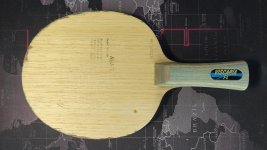Wrighty,
A lot of my main comments have been made already, but I would start with trying to get you to hit a fullbody stroke in practice. Unfortunately, my former internet coach has removed all his videos from the internet, but I am a believer that taking your most power CIRCULAR shot (circular shot/curved shot creates spin) while trying to not get injured doing it is a good thing for your technique.
The key to more powerful technique is to use more of your BODY to engage more quality in the stroke. Obviously the legs, the core (especially the core), and use those to transmit power to your arms. All good table tennis strokes should make you feel like you are a top, a helicopter, a windmill, a frisbee thrower etc. There is a circular aspect to good TT - because all our joints are round, all our swings have curves.
The biggest reason your strokes lack power is that you mostly use the upper arm and you use it to swing upward, but you don't swing upward and forward, which is what a helicopter motion with your core would enable you to do. You can do both upward and forward (forward OVER the ball)! You get good spin by doing both. That is why I would encourage you try windmill looping within the limits of injury. Remember, power doesn't come from how hard you swing the arm, it comes from how well you can transmit the power from your core into the arm.
Even away from the table, practice golf swings, or even try to make your bath towel whip. Do it in front of a mirror and see what you have to do to get your upper body engaged and not just your arm. Table tennis loops are throwing motions, just like punchs and frisbee tosses. Try to practice tossing a frisbee and whatever toss technique is getting you the most power is likely exactly how you should play your forehand.
All of the above has the caveat that we are adult learners, so we must always prioritize injury prevention. For a video example of windmill looping (more in a smashing context on an easy ball, again with the caveat that I am not asking you to be Zhang Jike), look at how Jike plays this point:
https://youtu.be/7RO2iTW4yN0?t=52
Note the repeated circular throwing motions to play smashes. Practice some of those smashes so you can get a better feel of getting your body to hit the ball hard.
The point of this is not to get you injured - the point of this is to help you see the concept that gets good balls to go through the table. You have to use the body to move the arm and then throw it forward and upward over the ball, Try practicing the topspin smashes to get a good idea for the potential. Start it on easy balls. Do it fairly slowly to get a good feel of how power goes from the body to the arm. Don't try to throw as hard as you can, throw as relaxed as you can with a full body stroke. If you feel like a whip, you have it right. If you feel you are muscling the ball, you have it wrong.
Then take that feeling in the arm, and make it smaller and smaller..











